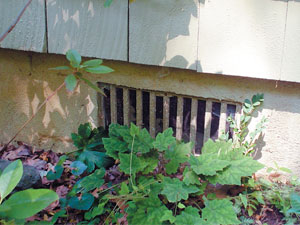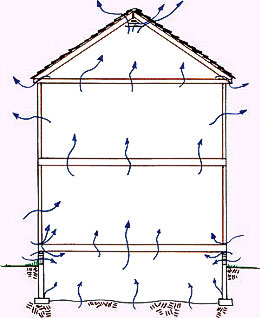Serving Greater Edmonton, St. Albert, Sherwood Park, Red Deer
1-780-474-8099Crawl Space Ventilation Near St. Albert, Edmonton, Sherwood Park
How Crawl Space Vents Affect Crawl Space Humidity... And Why

Crawl space vents can usually keep out mice and rodents, but what about termites, carpenter ants, and other insects?
Crawl Space ventilation is the answer that contractors have historically given to the issue of crawl space humidity in homes.
Generally, this involves installing vented openings in cross-sectional area equal to 1/150 of the floor area served. The theory is that air circulates through the crawl space to dry it and the humid air out.
These crawl space vents are usually fitted with a covering -- usually a wooden or metal grating, or a mesh covering.
The covering is sometimes installed to prevent infestations from rodents and animals, but they cannot prevent small insects such as termites, fleas and carpenter ants.
Plus debris comes into the home through these open slats if not covered.

Crawl space ventilation moves outside air through the house. This affects utility bills and, when that air holds mold spores, your health.
The Theory (and Myth) Behind Vented Crawl Spaces
Crawl space ventilation was meant to keep a constant supply of fresh air circulating throughout the crawl space environment.
It was thought that this would help to purge the space of the heavy, damp air in the house that settles in the lower levels.
Additionally, some misguided contractors claim that damp, humid air is heavier than dry air, causing all the moisture in the home to sink down into the crawl space.
This belief had become so widespread that crawl space vents were actually written into the International Building Code!
We all know and have felt (especially in summer months) how hot air rises as it heats up.
In recent years, however, these codes are quickly changing to reflect improvements in the industry and scientific study. This is important because with newer methods of drying crawl spaces out, better results have been achieved.
What Crawl Space Humidity Research Says
Consider these crawl space humidity facts:
- Isaac Newton discovered in 1717 that wet air is actually lighter than dry air! It makes a lot of sense - if damp air was heavier, what would clouds be made of? And why would crawl space vents, which are at ground level, ever bring dry air into your home?
- If it's rainy, humid, foggy, or snowing outside, you're bringing wet air into your home.
- Advanced Energy reports that crawl space ventilation brings wet air into your home [PDF] when it's wet outside. Water that is pooling around your vents, will also flow into the space.
- Crawl space moisture helps mold, rot, and mildew grow. This means serious damage for your crawl space!
Here's a little more science: Hot air rises, leaving your house through the roof and upper levels. This creates a vacuum below that is filled by air from your crawl space, basement, and from outside. Air in your crawl space eventually enters the rest of your home!
Consider These Two Scenarios:
Winter Air - Frigid air fills your crawlspace, making the floor above cold. It cools your hot water pipes, your water heater, your furnace, and your heating ducts. Your utilities work harder and cost you more to run, and your home is drafty and uncomfortable.
Summer Air - Hot, humid air enters the crawl space, where the earth cools it naturally. According to Builder Magazine [PDF], this humidity will lead to condensation on your pipes, wood, and cool surfaces, leading to mold and rot. Damp air rises upward into your home. Wet air is harder to cool than dry air, and you spend more on utilities. Meanwhile, your crawl space insulation gets wet, loses its insulative value, grows mold, and drips to the floor. Moist, rotting wood is a perfect place for termites, ants, rodents, and other creatures to move in!

When crawl space insulation is saturated with water, it drips off onto the floor.
Crawl Space Encapsulation
Crawl space ventilation does not work. If your crawl space is rotting and moldy, then you already know this.
To protect your crawl space, follow these steps:
- Eliminate any flooding with a crawl space sump pump system
- Seal your crawl space vents and doors with airtight covers.
- Line your crawl space walls and floors (even if they are concrete) with a thick, durable plastic liner
- Install a self-draining, strong dehumidifier in the crawl space.
This keeps everything you don't want in your crawl space outside- including moisture, cold air, termites, and ants. Your crawl space will be dry and usable as storage space, and as an added benefit, a crawl space liner will even serve as a passive radon mitigation system!
Basement Systems Edmonton would like to help you create a dry, healthier crawl space. If you'd like a free, on-site consultation, call or e-mail us today!
We service Alberta, including Grand Centre, St. Paul, Kitscoty, Wainwright, Cold Lake, Bonnyville, Edson, Rosevear, Edgerton, Elk Point, Vermillion, Conklin and nearby areas.
More information about Crawl Space Vapor Barriers
Looking for a price? Get a no cost, no obligation free estimate.

